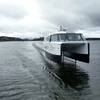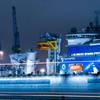Gladding-Hearn Bags Hy-Line Cruises Catamaran Order
Hy-Line Cruises, a division of Hyannis Harbor Tours, Inc., Hyannis, Mass., has ordered a new 493-passenger, high-speed catamaran from Gladding-Hearn Shipbuilding, the Duclos Corporation. The fourth Incat-Crowther fast ferry built by the Mass.-based shipyard for the Cape Cod passenger ferry company is larger and more stylish in design than previous vessels. The new ferry will provide year-round passenger service between Hyannis and Nantucket Island. Delivery is scheduled for 2016.
The new, all-aluminum ferry is about 153.5 feet (46.8 m) long, 34.5 feet (10.5 m) at the beam, and draws approximately 8 feet (2.5 m), loaded. The vessel will be powered by four Cummins QSK60-M, EPA Tier 3 diesel engines, each delivering 2200 Bhp at 1800 rpm. Each engine will be propellhttp://www.gladding-hearn.com/pop_up/passenger/passenger_3.gifed by a Hamilton HM721 water jet through a Twin Disc MG61500SC horizontally-offset gearbox. The ferry’s top speed will be over 30 knots when fully loaded at a dead weight of more than 64 tonnes, said Peter Duclos, president of the shipyard. In the event of a failure of one of the propulsion systems, the boat will still keep the schedule, but will require full power from the remaining three engines.
“This kind of margin and redundancy is just prudent business for a ferry that will operate close to 5,000 hours per year,” said Duclos. Each hull will be equipped with a 125 kW Cummins QSB7-D(M), EPS Tier 3 generator.
Similar to Hy-Line’s current high-speed catamarans, the new ferry will be outfitted with a Naiad Dynamics trim tab ride control system to improve passenger comfort and safety. The system’s motion sensor measures the relative movement of the vessel and transmits an electrical signal to the appropriate hydraulic device to counter the boat’s action through the waves, Duclos explained. “By keeping the unwanted motion and steering to a minimum the system can also minimize the speed loss in rough seas.”
The main cabin seats 163 passengers and includes a full service concession, heating and air conditioning, two heads, and a large luggage room aft. An etched-glass screen will separate the passenger seating area from the concession and condiment counters. The second deck, with interior seating for 155 passengers, features heating and air conditioning, premium seating forward, three heads, interior and exterior cocktail bars, and exterior seating for 46 passengers. The premium seating area is separated from the main passenger area by a half-height bulkhead with glass screens. The third deck, with the pilothouse forward, provides exterior seating for 129 passengers. Access to the wheelhouse, which is equipped with centerline and port and starboard engine and waterjet controls, is from exterior doors in the aft bulkhead. The design calls for Beurteaux seats and tables in the cabins and on the exterior decks.












